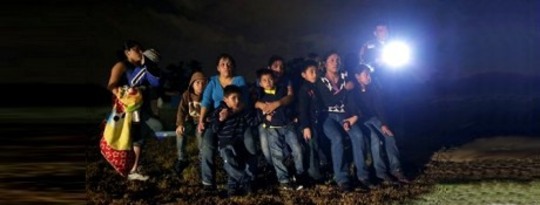
So far this year, more than 48,000 undocumented minors have been detained while crossing the U.S. border from Mexico. But increasingly, the kids aren't from Mexico. They're from Honduras, Nicaragua, and El Salvador, and they're fleeing from violence and poverty in their home countries, according to Reuters.
On Tuesday, July 3, 2014, President Obama described the issue as "an urgent humanitarian situation," and called for $3.7 billion in funding to address it. The money would have been used to build more immigrant detention facilities, and hire more Border Patrol agents and immigration court judges.
But Congress voted down the president's request. Meanwhile, undocumented kids continue to flow into the U.S. at a rate of more than 1,000 per week. And the kicker is that many of them are unaccompanied—kids as young as seven years old are making the dangerous trek to the U.S.-Mexico border without parents or guardians.
Why Is This Crisis Happening?
We've got a lot of questions: Why is this crisis happening? How did things get so bad in Central America, and what can we do about it? But the most pressing question is what to do with the kids who are already in the U.S. At present, they are being thrown into detention centers while the backlogged immigration courts decide their cases—a process that can take several months.
 Some politicians are calling to deport the children straight away while others, like Dallas County Judge Clay Jenkins, want to provide humanitarian relief to as many of them as possible.
Some politicians are calling to deport the children straight away while others, like Dallas County Judge Clay Jenkins, want to provide humanitarian relief to as many of them as possible.
In the video segment below, comedian Jon Stewart analyzes the crisis and the responses of various politicians. Stewart also offers his own solution for dealing with the children: "Shout at them in a language they don't understand."
In comparison to some of the politicians' suggestions, Stewart's seems almost sensible.
Watch the Jon Stewart clip here.
This article originally appeared on YES! Magazine
 About The Author
About The Author
Molly Rusk is a recent graduate of the program in Creative Writing at the University of Washington and an online reporting intern at YES! Follow her on Twitter @mollylynnrusk.
Recommended book:
Sharing is Good: How to Save Money, Time and Resources through Collaborative Consumption
by Beth Buczynski.
 Society is at a crossroads. We can either continue on the path of consumption at any cost, or we can make new choices that will lead to a happier, more rewarding life, while helping to preserve the planet for future generations. Collaborative consumption is a new way of living, in which access is valued over ownership, experience is valued over material possessions, and "mine" becomes "ours," and everyone's needs are met without waste. Sharing is Good is your road map to this emerging economic paradigm.
Society is at a crossroads. We can either continue on the path of consumption at any cost, or we can make new choices that will lead to a happier, more rewarding life, while helping to preserve the planet for future generations. Collaborative consumption is a new way of living, in which access is valued over ownership, experience is valued over material possessions, and "mine" becomes "ours," and everyone's needs are met without waste. Sharing is Good is your road map to this emerging economic paradigm.
Click here for more info and/or to order this book on Amazon.























